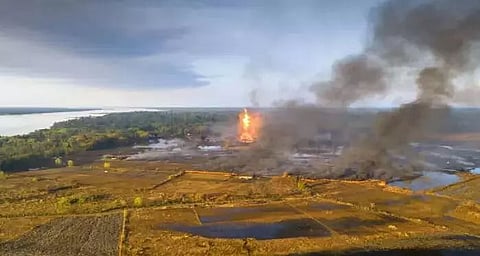
- Home
- Live Blog
- Breaking News
- Top Headlines
- Cities
- NE News
- Sentinel Media
- Sports
- Education
- Jobs

Trishita Shandilya
(The writer can be reached at Trishita.shandilya@gmail.com)
The recurring Baghjan blow-up incidents and its concomitant saga of after-effects again have reassured the deceit model of mineral-based economic approach. The crux of the matter is whether this economic model is appropriate in a natural milieu like Assam or in a broader sense — in the north-eastern part of India. In the north-eastern region — a part of the Eastern Himalayan biodiversity belt— if the region's natural milieu is considered as the base, it constructs the socio-cultural milieu of its inhabitants and it determines the economic ethos for many indigenous communities. The very mineral-based economic model has a direct impact not only on the ecology of the region but also it impacts negatively the socio-cultural and economic milieu of many indigenous communities. The link among these elements can be elaborated through the discussion on the devouring character of the mineral-based economy which nurtures exploitation. By reiterating the obvious fact, it can be said that the act of mineral extraction not only triggers changes in the nearby ecology, it corresponds changes in the broader ecosystem i.e., the water body and the aqua species, other plants which are also the house of various species etc., face the plight of destruction. The oil-quoted water bodies in the Baghjan area after the blowout, the floating dead aqua species, and other animals along with the casualties of human beings in the area are very much reflecting the linkage among ecology, human social milieu and the mineral-based economic practice. Its deep-rooted damage will be seen soon in the form of various socio-economic crises of the residents in the area, provided the ecological damage due to the blowout is going to be a long-lasting one.
However, the Baghjan incident is one of the many such incidents which time and again reflect the failure to wisely use the potential of nature, instead reflect resource devouring the economic model. Thereby, such incidents highlight the swindle of growth-oriented development model. Such model of development is socialized by the lust of the powerful lobby who gains profit through the culture of exploitation of many. In the context of the north-eastern region of India, these kinds of development model (which includes the mineral-based economic projects) have been exploiting the geographical location of the region by commodifying and extracting its resources whereby violating the rights of numbers of indigenous communities, who are deprived from the practice of nature- cohabitation and also deprived from their nature worshipping cultural, spiritual, social, political and economic practices.
Is this the only model available for the practice of progress? The answer is obviously no. There are widespread discussions about various alternative models of development. One of such alternatives that can be proposed, considering the unique natural milieu of the north-eastern region, is the transferring of the ongoing theoretical emphasis on the lived experiences of the region and its communities into the practice through imposing the consideration of lived experiences of the region into the realm of policies made for the region.
The model which may become a solution for the region is the regenerative bio-economic model which can lead to the edifice of development approach by facilitating the circulation of resource use and its regeneration without leading to its destruction. The careful framing of development-based policy with the principle of regenerative bio-economic approach along with the recognition of the lived experiences of inhabitants in the socio-ecological milieu the region can be an alternative to the mineral-based economic model.
However, it is noteworthy that in the process of adaptation of regenerative development model, the various existent elements of social stratification in the social milieu — in the perspectives of gender, clan, class, caste or other social identity-based social divisions – are important to be recognised so that the framework of such a regenerative model can create equitable as well as equal space for all social groups.
At last, when question is raised against the discrepancies related to the Baghjan blowout incidents, questions also should be pointed towards the very growth-oriented nature-devouring model of development. Moreover, the Baghjan blowout incident, in the broader framework, cannot be separated from the various other incidents that have happened in the recent period due to the endorsement of the political power towards direct or indirect destruction and exploitation of natural resources and thereby jeopardizing the rights of various indigenous communities to practice their culture as well as livelihood. To raise such exploitative practices, the initiative of grassroot-based movements and mobilization is the need of the hour; and such mobilizations may pave the way towards the process of 'ecological democracy'.
Ashish Kothari (2014), an acclaimed environmentalist of the country, opined that the 'radical ecological democracy' can lead towards a 'sustainable and equitable alternatives' i.e., as an alternative to the dominant economic model.